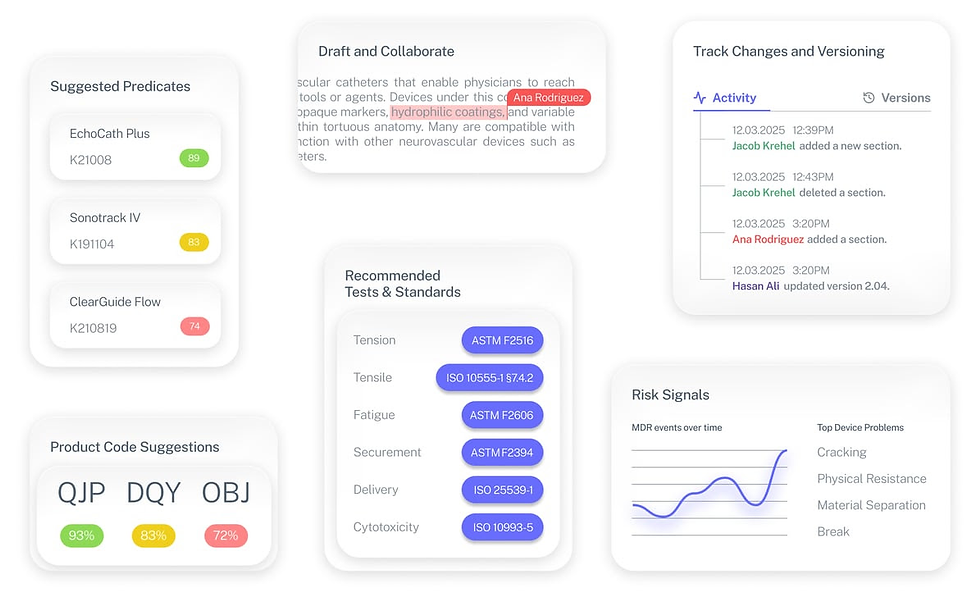FDA Unique Device Identification (UDI): Complete Guide for Medical Device Manufacturers
- Beng Ee Lim

- Dec 6, 2024
- 4 min read
Updated: Sep 7
FDA’s UDI system requires most device labels and packages to bear a Unique Device Identifier—in human-readable and AIDC (barcode/2D/RFID) form—and for key device data to be submitted to GUDID. A UDI has a Device Identifier (DI) and optional Production Identifiers (PI); certain reusable reprocessed devices also need direct marking.
This guide will break down the UDI system, its components, compliance steps, and how manufacturers can overcome challenges to ensure adherence to FDA standards.

What is the UDI System?
The FDA’s Unique Device Identification (UDI) system is designed to assign a unique identifier to every medical device distributed in the United States. This system improves the traceability of devices from production to patient use, ensuring faster recalls, better safety, and streamlined inventory management.
Why Did the FDA Introduce the UDI System?
The UDI system aims to:
Enhance patient safety by enabling rapid identification of problematic devices during recalls or adverse events.
Improve post-market surveillance by tracking devices throughout their lifecycle.
Streamline supply chain management and reduce medical errors.
Key Components of the UDI
Every UDI consists of two primary parts:
Device Identifier (DI)
The fixed portion of the UDI.
Identifies the labeler and the specific version or model of the device.
Production Identifier (PI)
The variable portion of the UDI.
Includes manufacturing details such as lot/batch number, serial number, manufacturing date, and expiration date (if applicable).
Labeling Requirements
Manufacturers (referred to as labelers) must include the UDI on device labels and packaging in both:
Plain Text: Human-readable format.
AIDC Format: Machine-readable format, such as a barcode.
For reusable devices requiring reprocessing, the UDI must also be directly marked on the device unless exempted.
Understanding the Global Unique Device Identification Database (GUDID)
The Global Unique Device Identification Database (GUDID) is the FDA’s repository for device identification information. It serves as a public reference catalog for devices with UDIs.
Submitting Data to GUDID
Manufacturers must submit specific device details to GUDID, including:
Device Identifier (DI)
Device description
Labeler information
Device status (active or discontinued)
Accessing the GUDID Database
The GUDID is accessible to the public via AccessGUDID. This transparency benefits healthcare providers, regulators, and patients by providing detailed information about medical devices on the market.
Compliance Deadlines for UDI
The FDA has implemented a phased rollout for UDI requirements based on device classification:
Class III Devices: Compliance required first due to higher risk.
Class II Devices: Intermediate deadline for moderate-risk devices.
Class I Devices: Final phase covering low-risk devices.
Missed deadlines can result in penalties, delays in product approvals, or removal of devices from the market.
Benefits of the UDI System
For Patients
Quicker response during recalls.
Enhanced safety through precise device tracking.
For Manufacturers
Streamlined inventory management.
Easier compliance with post-market surveillance requirements.
For Healthcare Providers
Reduction in medical errors through accurate device identification.
Simplified management of device recalls and replacements.
Common Challenges in UDI Implementation
Technical Challenges
Formatting UDIs for both plain text and AIDC requirements.
Ensuring compatibility with barcode scanners and software systems.
Logistical Hurdles
Managing data submission for large product portfolios.
Coordinating updates to packaging, labels, and production lines.
Training and Understanding
Ensuring teams understand UDI requirements and their role in compliance.
How to Overcome UDI Implementation Challenges
Leverage Compliance Tools
Use software solutions to automate UDI generation, labeling, and GUDID submissions.
Train Your Team
Provide regular training sessions to ensure all employees understand UDI requirements and processes.
Partner with Experts
Engage regulatory consultants or tools like Complizen to guide your compliance efforts.
Conclusion
The FDA’s Unique Device Identification system is a game-changer for the medical device industry. By enhancing traceability and safety, the UDI system benefits everyone—from patients and healthcare providers to manufacturers and regulators.
Proactive planning, robust systems, and leveraging tools like Complizen can help you stay compliant and ahead of the curve. Embrace the UDI system not as a regulatory hurdle but as an opportunity to improve safety and operational efficiency.
The Fastest Path to Market
No more guesswork. Move from research to a defendable FDA strategy, faster. Backed by FDA sources. Teams report 12 hours saved weekly.
FDA Product Code Finder, find your code in minutes.
510(k) Predicate Intelligence, see likely predicates with 510(k) links.
Risk and Recalls, scan MAUDE and recall patterns.
FDA Tests and Standards, map required tests from your code.
Regulatory Strategy Workspace, pull it into a defendable plan.
👉 Start free at complizen.ai

FAQs
What is the UDI system?
The UDI system assigns a unique identifier to every medical device, improving traceability, safety, and compliance.
What are the two parts of a UDI?
The UDI includes:
Device Identifier (DI): Fixed information identifying the device and labeler.
Production Identifier (PI): Variable information such as lot number and manufacturing date.
What is the GUDID?
The Global Unique Device Identification Database (GUDID) is an FDA-managed database where manufacturers submit UDI-related device information.
What happens if I miss a UDI compliance deadline?
Missing deadlines can result in penalties, regulatory actions, or removal of non-compliant devices from the market.
How can Complizen help with UDI compliance?
Complizen simplifies UDI implementation by providing tools for GUDID submissions, labeling, and guidance document access.



